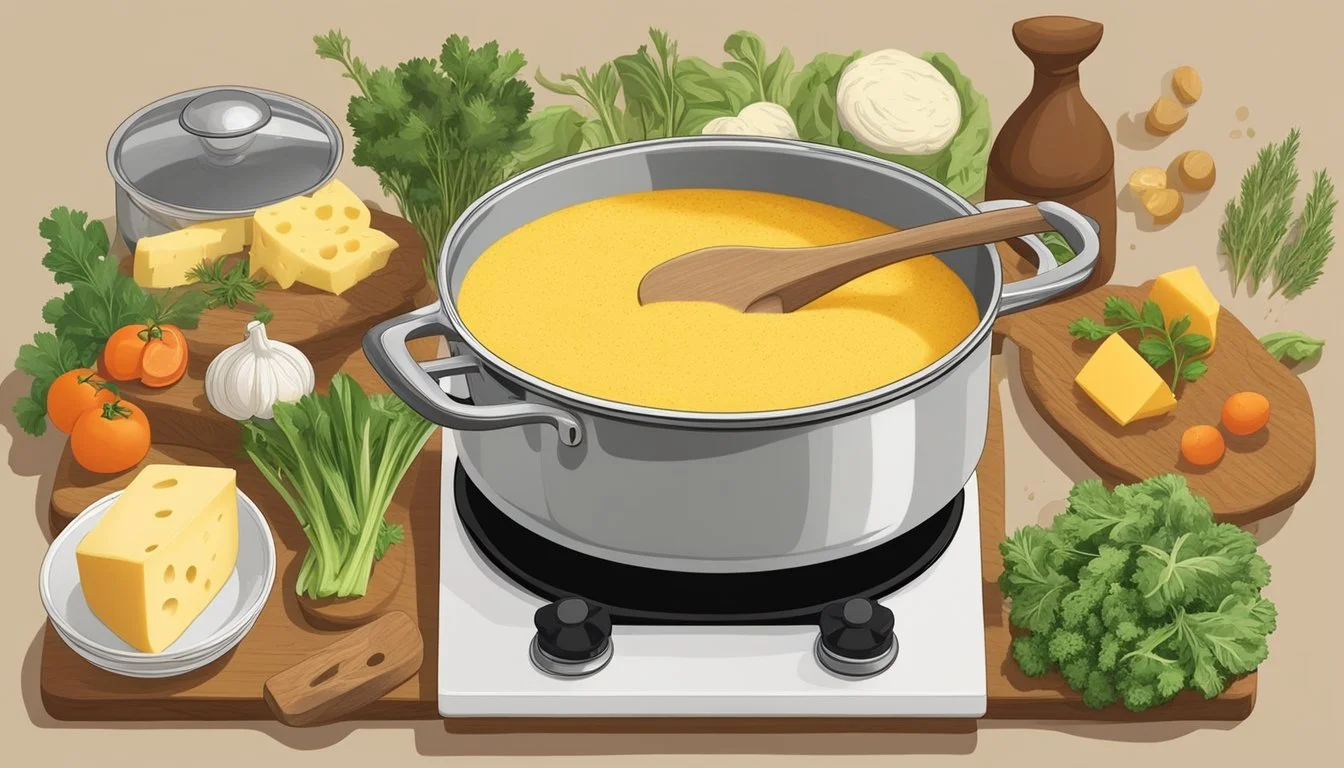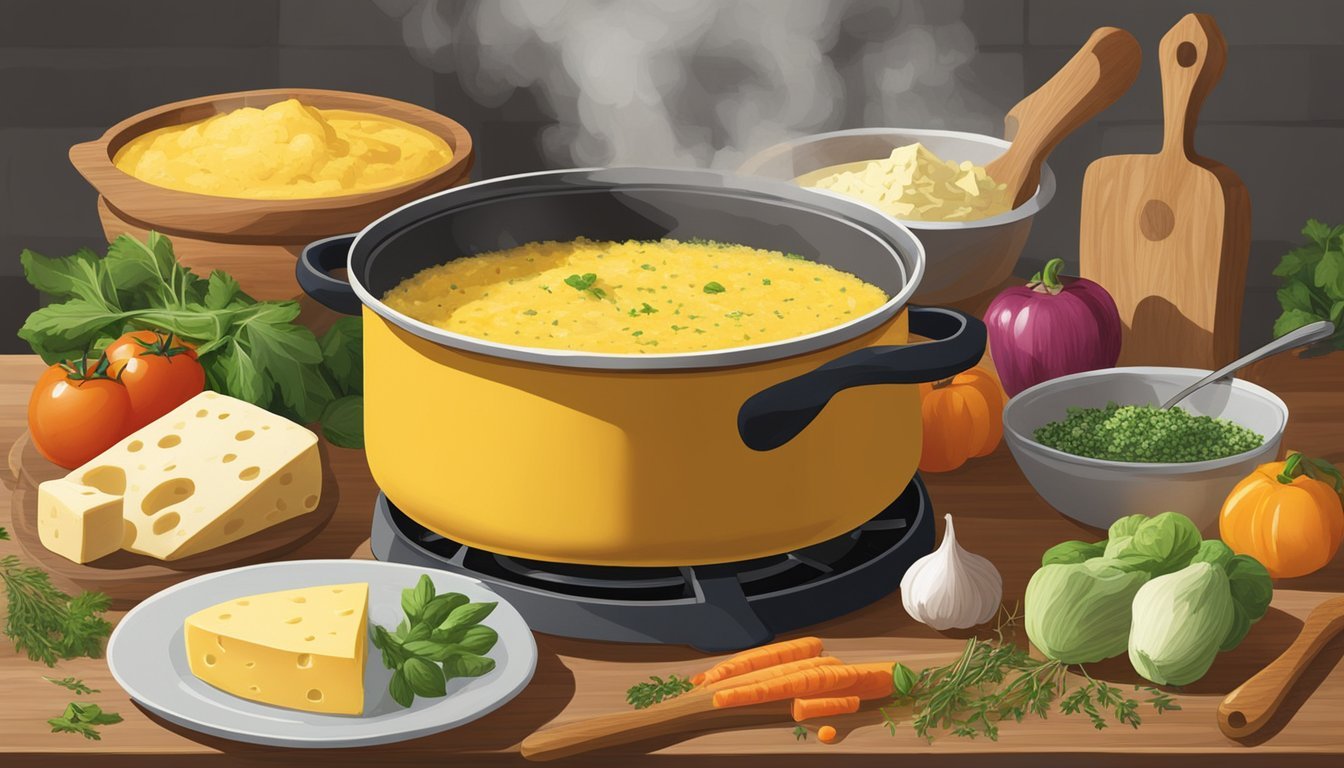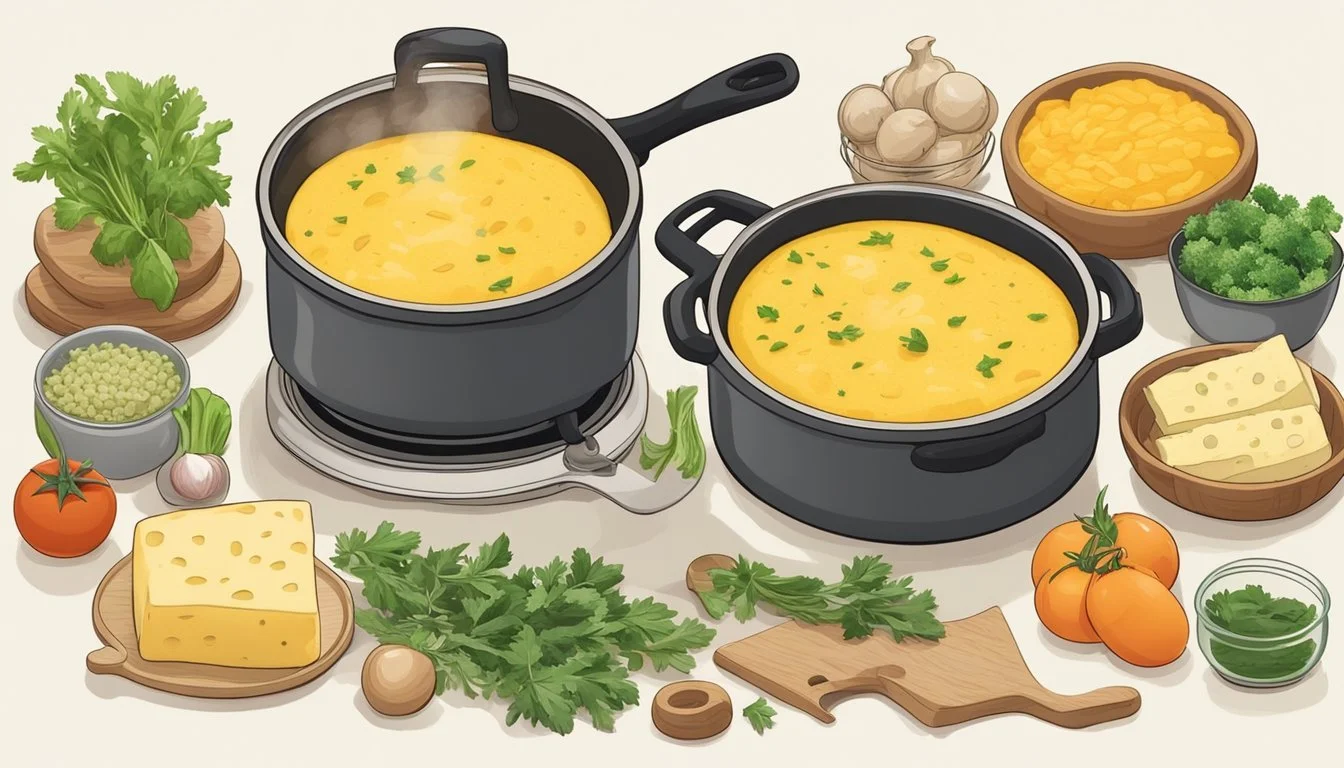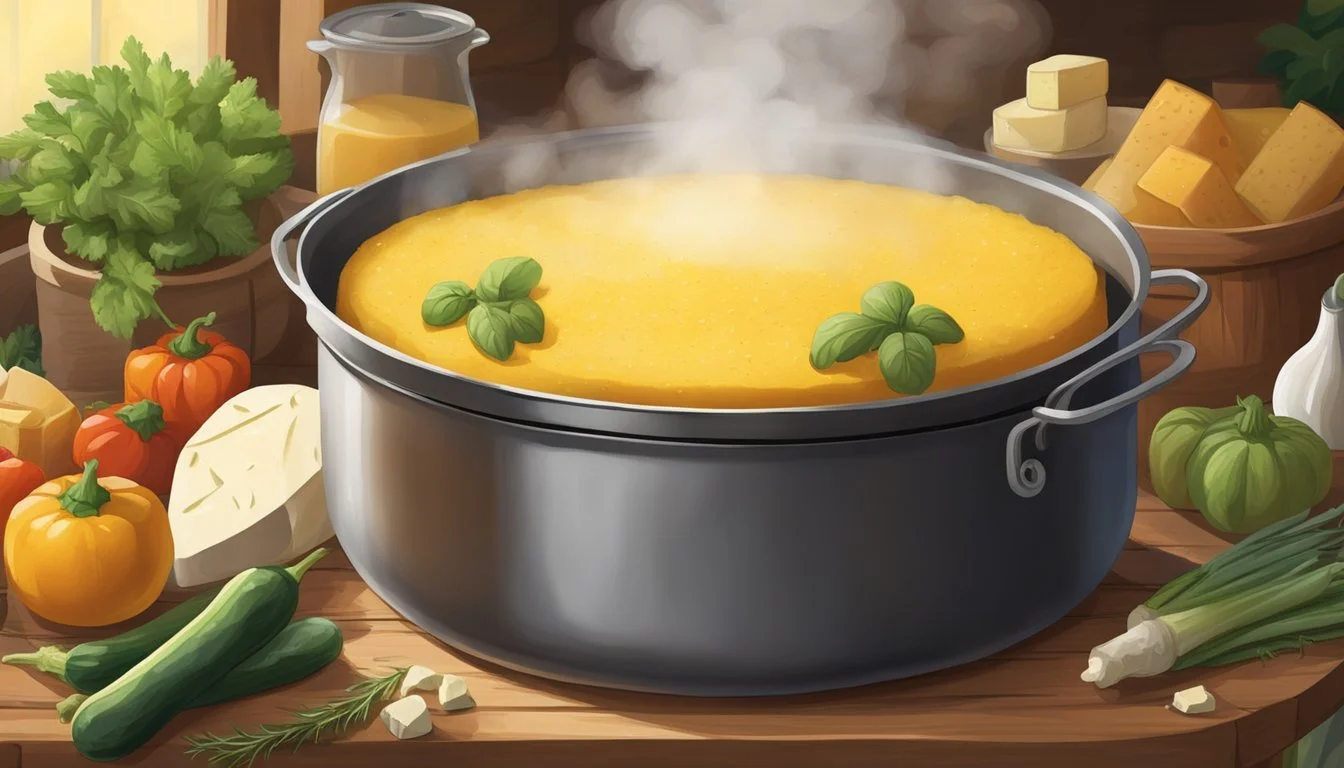How to Cook with Polenta for Comforting Meals
A Simple Guide
Polenta, a dish steeped in history, has evolved from its humble beginnings into a versatile staple in kitchens worldwide. Originating from ancient grains, its current form began taking shape in Italy with the introduction of corn in the 16th century. Today, polenta serves as a grounding element for countless dishes, from the creamy to the crisply fried. As a comfort food, it offers a warm, satisfying experience that pairs well with an array of flavors and ingredients.
The process of cooking polenta is straightforward and forgiving, making it an ideal option for those seeking nutritious, easy-to-make meals without fuss. Polenta’s health benefits emerge from its base of whole grain cornmeal, rich in fiber and free of gluten, accommodating a variety of dietary preferences. Moreover, its affordability is a relief for the budget-conscious, ensuring a place in the pantry of cost-effective cooks.
Chefs and home cooks alike revel in the culinary flexibility of polenta. It can be tailored to taste preferences and meal requirements, whether one desires a plush bed for robust sauces and braised meats (What wine goes well with braised meats?) or a golden-brown crust as a base for vegetables and cheeses. Its simplicity in preparation belies the depth of texture and flavor it can bring to the table, making polenta a quintessential component for comforting meals that nourish both body and spirit.
Understanding Polenta
Polenta is a versatile corn-based staple originating from Italy, which can be served creamy or set into a loaf and sliced. Here's a deeper look into what polenta is, its different forms, and its nutritional aspects.
The Basics of Polenta
Polenta is made from ground yellow cornmeal. It is traditionally cooked in boiling water or broth, stirred continuously until it reaches a thick consistency. The process requires patience as it can take anywhere from 45 minutes to one hour to achieve the perfect, creamy texture. Polenta is naturally gluten-free, making it an excellent option for those with gluten sensitivities.
Traditional Polenta vs. Instant Polenta
Traditional polenta demands a longer cooking time, where one constantly stirs to prevent lumps and achieve a smooth, creamy dish. On the other hand, instant polenta is pre-cooked and dried for convenience, significantly reducing the cooking time to mere minutes. This quick version is ideal for those looking for a fast and comforting meal without the lengthy preparation.
Nutritional Profile of Polenta
Polenta provides a nutritious alternative to other grains and is particularly noted for being gluten-free. A serving primarily offers carbohydrates with a moderate amount of dietary fiber. Here's a brief nutritional breakdown:
Calories: Approximately 70-80 per 100g serving
Carbohydrates: Roughly 15-17g
Fiber: About 2g
Protein: Generally 2-3g
Polenta can be enriched with vitamins and minerals, depending on the cornmeal used. It can serve as a wholesome base for a variety of toppings and ingredients, from savory vegetables to rich cheeses.
Preparing Polenta
The key to a satisfying polenta dish lies in the selection of the right cornmeal and understanding the best cooking practices to achieve a creamy consistency.
Choosing the Right Cornmeal
For polenta, one must use the appropriate type of cornmeal to ensure the proper texture. The choice of cornmeal largely impacts the final dish's creaminess and flavor. Medium or coarse ground cornmeal is typically preferred for polenta as it provides a better texture than fine ground cornmeal.
Polenta grain sizes:
Fine: Smooth texture, but can become dense.
Medium: Balanced texture, ideal for a creamy finish.
Coarse: Rustic texture, requires longer cooking time.
Cornmeal labeled as "polenta" indicates that it's the appropriate grind for the dish. While pre-cooked or "instant" polenta is available, these options often compromise on flavor and texture. Choosing high-quality, stone-ground cornmeal can make a significant difference.
Cooking Methods
There are various means to cook polenta, including stovetop simmering, baking in the oven, or using modern appliances such as the Instant Pot. Each method requires a different level of attention and time commitment.
Stovetop: This traditional approach involves simmering polenta in water, stirred frequently until thickened. It usually takes about 45-60 minutes.
Oven: A less labor-intensive method, baking stirs polenta into boiling water, then baking it at a moderate temperature, allowing for a slow, even absorption.
Instant Pot Polenta: For a hands-off approach, the Instant Pot can be used. This method typically requires less attention and a shorter cooking time.
Ultimately, the stovetop method provides the most control over the consistency, but the oven and Instant Pot offer convenient alternatives.
Mastering Creamy Polenta
To achieve a perfect creamy polenta texture, one must be patient and attentive during the cooking process. The steps are sequential, and attention to detail is crucial.
Begin with a 4:1 liquid to cornmeal ratio (using water, broth, milk, or a blend), bringing the liquid to a light simmer.
Whisk in the cornmeal slowly to prevent lumps, then reduce the heat to a gentle simmer.
Stir regularly, allowing the cornmeal to absorb the liquid and swell, which usually takes about 30-40 minutes for medium grind cornmeal.
To finish, incorporate butter and an optional spoonful of cream, enhancing richness and contributing to the polenta's creamy texture.
Polenta serves as a naturally gluten-free foundation for a multitude of dishes, offering comforting warmth and versatility. Whether served soft and plush or allowed to cool and then grilled or fried, its creamy consistency is the hallmark of properly-prepared polenta.
Customizing Your Polenta Dish
Customizing polenta is straightforward: it allows for various adaptations including vegan and vegetarian options, the addition of rich dairy like cheese and butter, and it serves as a versatile base for a range of toppings.
Vegan and Vegetarian Options
Polenta is inherently vegetarian, and it can easily become a staple in vegan diets as well. For a simple Easy Vegan Polenta, one substitutes the traditional dairy with plant-based alternatives like almond or soy milk, and adds nutritional yeast instead of cheese, to offer a savory, cheese-like flavor. Enhance the dish with a medley of grilled vegetables or top it off with a hearty tomato sauce featuring meatless meatballs or vegan sausage.
Incorporating Cheese and Butter
To transform plain polenta into a Creamy Parmesan Polenta, stirring in butter and grated Parmesan cheese during the final cooking stages is key. The butter adds richness, while the Parmesan imparts a delightful umami flavor. One might also explore using other cheeses such as cheddar for sharpness, or gorgonzola for a pungent kick.
Using Polenta as a Base for Various Toppings
Versatile in nature, polenta provides an excellent base for various toppings. Think of it as a canvass, where one can layer flavors. It can be served soft, like a creamy bed for meaty toppings like sausage or meatballs, or allowed to cool and solidify, then sliced to create a Polenta Pizza with a crisp exterior. Alternatively, it can be baked as a Polenta Cake, topped with roasted vegetables (What wine goes well with roasted vegetables?) or a medley of wild mushrooms (What wine goes well with mushrooms?) for earthiness.
Recipe Ideas
Polenta, a versatile base made from ground cornmeal, lays the foundation for a myriad of dishes. From traditional Italian classics to innovative twists and international flavors, its adaptability makes it ideal for various recipes that promise comfort in every bite.
Classic Polenta Recipes
Traditional polenta dishes are simple yet rich in flavor. One popular staple is creamy polenta, often served with a robust topping, such as a red sauce or cheese. Here are a few classic recipes to try:
Cheesy Mushroom Polenta with Bacon: A combination of sautéed mushrooms and crispy bacon on top of smooth, cheese-infused polenta.
Roasted Tomatoes with Goat Cheese Polenta: Slow-roasted tomatoes paired with creamy goat cheese polenta make for a delightful dish, balancing the acidity of tomatoes with the richness of cheese.
Innovative Polenta Creations
Polenta's neutral taste lends itself to innovative culinary experiments. Creative polenta recipes include:
Baked Polenta Fries: A departure from traditional fries, polenta is cut into strips, baked until crispy, and can be dipped in aioli or pesto.
Ingredients Description Precooked Polenta Sliced into long strips and baked Seasonings Enhance with paprika or Italian herbs
Polenta Lasagna: Swap pasta sheets with polenta for a unique twist on the Italian classic lasagna, layered with cheese, meat, and sauce.
Polenta in International Cuisine
Polenta is not confined to Italian cuisine; it's enjoyed in various forms across the world:
Mamaliga Recipe: This Romanian version of polenta is typically denser and can be sliced and served with cheese or sour cream.
Creamy Vegan Polenta with Mushrooms and Spinach: A dish appreciated by those following a plant-based diet, featuring a sumptuous topping of mushrooms and spinach over velvety polenta.
Lastly, polenta serves as an excellent base for main courses such as Herb-Crusted Pork Tenderloin or Spicy Shrimp, providing a creamy contrast to the texture of the protein. Whether it's served alongside roasted broccoli, as in a Chicken and Polenta dish, or topped with aromatic spices, polenta remains a steadfast key to creating comforting meals.
Alternative Uses for Polenta
Polenta, a versatile cornmeal dish, serves not only as a creamy staple but also as a canvas for culinary innovation. When used creatively, it can enhance a variety of dishes, from sides to baked goods.
Polenta as a Side Dish
Polenta complements numerous main courses with its subtle corn flavor. It can be:
Grilled: for a smoky addition to your plate.
Baked: as polenta cake, serving as a sturdy yet tender base for layering flavors.
Polenta in Baking
Polenta isn't limited to savory applications; it also adds texture and moisture to baked goods. Polenta cake is a prime example, distinguished by its crumbly texture and buttery taste. Incorporating polenta into pastries offers:
A fine-grained texture that's ideal for creating a moist and hearty cake.
An absorbent quality, allowing it to take in fruit juices and syrups for enhanced flavor.
Fried Polenta and Other Variations
Fried polenta transforms the soft dish into a crispy delight, perfect for snacking or as an appetizer. Here is how one might prepare it:
Polenta Fries: Cut precooked polenta into fry-shaped sticks and bake until golden brown.
Ingredients Preparation Precooked polenta Slice into sticks Olive oil Drizzle and toss Salt, herbs Season to taste Bake ~25-30 minutes at 425°F
Polenta Pizza: Use a firm polenta base to create a gluten-free pizza crust. It can be topped with traditional pizza toppings (What wine goes well with pizza toppings?) and baked until the edges are crispy.
This array of adaptabilities confirms polenta's place both as a comfort food and as an ingredient ripe for experimentation.
Tips and Tricks
To ensure that your polenta is not just comforting but also memorable, one must pay attention to achieving the perfect consistency, storing it properly, and being smart with ingredient substitutions.
Achieving Perfect Consistency
The key to polenta that is smooth and creamy lies in patience and attentiveness. One should start with a ratio of 1 part polenta to 4-5 parts liquid, whether that's water, broth, or a mix of both. For a richer flavor, they can consider replacing some of the water with milk or cream. As they pour the polenta into the liquid, a slow and steady whisking helps prevent lumps. The polenta should be stirred frequently over low heat, taking approximately 20-45 minutes to cook, depending on the type.
Stirring: To avoid clumps and to achieve a velvety texture, continuous stirring is crucial.
Heat: A consistent, low heat helps the polenta absorb the liquid without scorching.
Storage and Reheating
Cooked polenta can be stored in the refrigerator for later use. One should cool it and place it in an airtight container, where it can last for up to a week. When reheating, adding a bit of water, milk, or broth can return the polenta to its creamy state.
To reheat, stir continually over low heat, effectively rehydrating the stiffened polenta.
If the polenta has been chilled and set, it can also be sliced and grilled or pan-seared for a delightful texture contrast.
Ingredient Substitutions
Flexibility in ingredients can help adapt polenta to various diets and pantry limitations. Here are some common substitutions:
Original Ingredient Substitution Note Dairy Milk/Cream Nut Milk Suitable for those avoiding dairy; it still adds creaminess. Parmesan Cheese Nutritional Yeast For a vegan option, while adding a cheesy flavor. Olive Oil Butter Offers richness and can be used for cooking or as a finishing touch.
Cooking polenta offers the opportunity to include various additions for enhanced flavor and texture. One can stir in fresh or roasted vegetables, parmesan cheese for umami depth, or a drizzle of olive oil for a fruity note. These pantry staples turn essential polenta into a versatile base suitable for an array of comforting meals.
Pairing Polenta With Other Foods
Polenta serves as a versatile base that can be enhanced with a variety of proteins and vegetables to create a hearty and comforting meal. Selecting the right accompaniments not only complements the mild corn flavor of polenta but also creates a balanced dish both in taste and nutrition.
Best Proteins to Pair With Polenta
Beef: Short ribs and steak add a robust flavor, making them a top choice to serve alongside creamy polenta.
Poultry: Chicken, particularly when it’s in a savory tomato sauce, offers a lighter protein option that pairs well with polenta's soft texture.
Pork: For a more savory taste, pulled pork and pork chops (What wine goes well with pork chops?) can be a satisfying match with polenta, especially when seasoned with herbs and pepper.
Seafood: Shrimp scampi (What wine goes well with shrimp scampi?) and skillet seared fish provide a delightful contrast to the rich, buttery polenta.
Vegetable Accompaniments
Mushrooms: Sautéed mushrooms, with their earthy tones, make for an excellent side that complements the corn base of the polenta.
Greens: Spinach and other leafy greens like kale can be braised or sautéed to add both color and nutrients to a polenta dish.
Roasted Veggies: A mix of roasted vegetables, seasoned with herbs, offers a sweet and savory flavor profile that enhances the polenta's inherent mildness.
Tomato-Based Sauces: A rich tomato sauce is a classic topper that pairs beautifully with the slight sweetness of polenta.
Creating Balanced Meals
To create a balanced meal with polenta, one should aim to include proteins, vegetables, and a source of healthy fats. For example:
For Breakfast: Serve polenta with sautéed spinach and a poached egg, drizzled with olive oil and a sprinkle of parmesan.
For Dinner: Pair herbed pork chops with a side of polenta topped with mushroom pepper ragout for a savory and satisfying meal.
Balancing flavors and textures ensures each meal with polenta is nutritious, comforting, and full of flavor.





